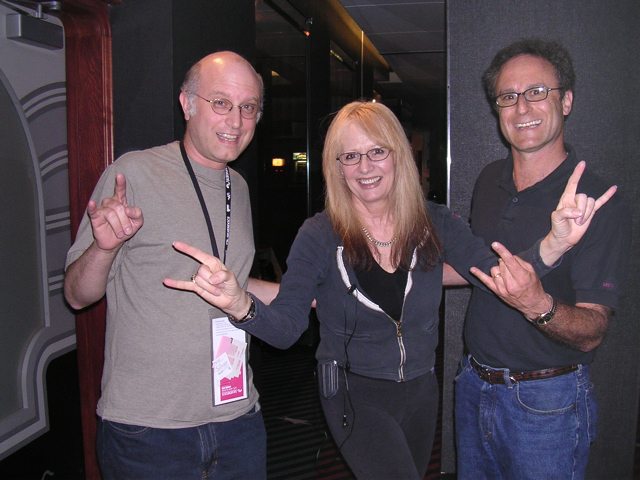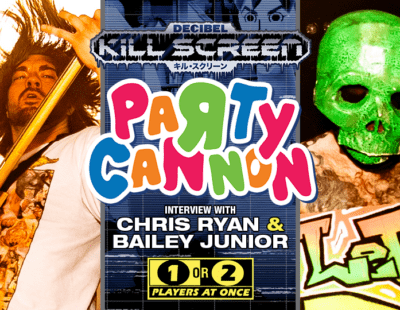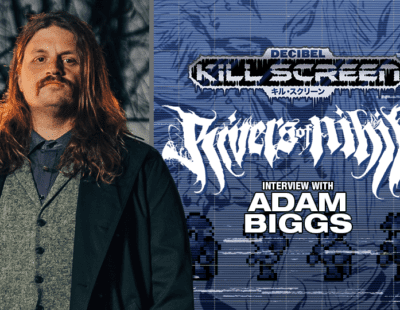The Landover, MD Judas Priest show, which served as the backdrop for all of the interviews conducted in the legendary documentary Heavy Metal Parking Lot, was held 30 years ago today! To celebrate, we’re re-posting Nick Green’s fantastic story—including interviews with filmmakers Jeff Krulik and John Heyn as well has original cast members—which Decibel first ran in our August 2006 issue (along with a massive 16-page Slayer oral history).
“Trying to deconstruct Heavy Metal Parking Lot 20 years later is like dissecting the Talmud. It has been a really weird journey,” explains Jeff Krulik, one of the two suburban Maryland filmmakers behind one of the all-time great rock ‘n’ roll documentaries, a Margaret Mead-style expedition into the raucous parking lot of a Judas Priest/Dokken concert. “I always tell people that you were either at this concert or you sat next to somebody in homeroom who was there. You didn’t have to be there to feel an immense connection with this scene. Everybody knew people who were like this.”
Krulik’s talking about the colorful parade of characters that populate the documentary he made with his buddy John Heyn in 1986, where non-ironic mullets and ¾ sleeve band shirts abound. Drunk chicks with feathered hair vow to take Glenn Tipton and “fuck his brains out” and “jump Rob Halford’s bones.” A shirtless dude who introduces himself as “Gram of Dope” vows to “smoke a joint so big it fits across America.” And in a sequence that has become the film’s defining moment, a mysterious figure fans have dubbed “Zebraman” (for his garish spandex outfit) defends his musical tastes with such ardor that he chips a tooth on the filmmakers’ microphone: “Heavy metal rules. All that punk shit sucks. It doesn’t belong on this world – it belongs on fuckin’ Mars!”
“I think my approach to making documentaries was just to seek out subject matter that people hadn’t tackled before,” says John Heyn, who sketched out the original idea for the film on a cocktail napkin. “I know that’s a pretty simplistic idea: filming people in a parking lot. But there wasn’t a whole lot of sociological analysis that went into it. I didn’t know much about Judas Priest, except that they were at the epicenter of the metal scene at the time. We weren’t really that into metal, so we didn’t approach it from that perspective. This was something that hadn’t been documented before, and I thought it was going to be pretty intense and subversive.”
The filmmakers didn’t have to struggle to find compelling material when they drove in to the parking lot of the Capital Centre – a rock mecca for concertgoers from Washington DC and Baltimore in the ‘70s and ‘80s – in Krulik’s Pontiac Bonneville on May 31, 1986. Krulik and Heyn took turns holding the clunk video camera and quizzing the dazed and confused subjects. They ultimately left with about an hour’s worth of footage, later pared down into a jaunty 16-minute film. The pair kept the overhead low by borrowing all of the equipment from the public access studio Krulik managed; Heyn edited the film together after-hours at the video duplication company he worked for at the time. Not only is HMPL one of the most unflinchingly honest depictions of rock ‘n’ roll fandom ever committed to film, it’s also one of the thriftiest.

Still, when the pair inventoried their footage, they had to revise their original plan of producing a segment for Krulik’s cable access station. “We knew immediately that it wouldn’t fly on public access and I had to worry about my job – I didn’t want to be flagrant about the fact that we recorded people swearing and drinking and carrying on,” explains Krulik. “The other thing is that video projection wasn’t widespread at the time; the film didn’t have any outlet outside of clubs or art galleries or home viewing on a VCR. You couldn’t submit a video to a film festival – that was unheard of. I used to hold screenings at my house for our friends all of the time. It wasn’t something we had a great agenda with, which turned out to be both good and bad. On one hand, it allowed for this grassroots charm. But not having a plan doomed the film to obscurity.”
Krulik and Heyn screened the film repeatedly at art galleries and clubs and record conventions around the Washington DC metro area over the next two years. Heavy Metal Parking Lot was well-received during a showing at the American Film Institute, and the pair got some encouragement from their filmmaking idol Penelope Spheeris after sending her a copy, but the film remained a local phenomenon. By the late ’80s, the pair had exhausted most of the HMPL’s natural venues and hatched their next big plan: to show the film to 15,000 fans on the telescreen when Judas Priest returned to the Capital Centre in 1988 on the Ram It Down tour.
“We eventually got backstage and showed it to the tour manager and the accountant,” says Krulik. “They were very cordial and nice, but they were more concerned about bootleg t-shirts than the fact that we had appropriated Judas Priest’s music. I think band management was ok with it as long as we didn’t show it right before Judas Priest went on. But the people running the telescreen balked – this was an era where the Beastie Boys and others were getting into trouble for their outrageous stage behavior. Arena management was trying to present a different image; they wanted to downplay the bacchanalia that was still going on out in the parking lot. That was a bit of a let-down, but we left copies for the band… and never heard from ‘em.”
Four years after the pair mutually decided to retire HMPL from public screenings, Heyn received a phone call from Sofia Coppola, who wanted to include the film in a show she was putting together for Comedy Central. Turns out, copies of the film Krulik made for a friend had turned up in the rental section of a cult movie store called Mondo Video in Los Angeles. And on Nirvana’s tour bus. And in the hands of every hipster on the California coastline. Coppola’s pilot never made it to the air, but a groundswell of interest encouraged Krulik and Heyn to pull the film out of mothballs, tour festivals, and begin work on a sequel of sorts, Neil Diamond Parking Lot. Still, how did this 16-minute short subject get its groove back after the filmmakers had all but left it for dead?
“Back here in D.C., we had kind of written it off,” says Heyn. “We had gone on to other jobs and projects and films, and it was kind of out of our orbit. But the film made its way around, up and down the Pacific coast in the early ‘90s and all the way down to Los Angeles, where it was being rented at Mondo Video. People kept making dubs of dubs of dubs and there were these multi-generational copies being circulated. The quality wasn’t that good, but I don’t know if that was even the point. As long as you could still hear the dialogue and make out the images of these characters, that was enough for people to experience it and develop an appreciation for it.”
“It was just passed around, man,” explains Mike Schleibaum, guitarist of Darkest Hour and a lifelong D.C. resident. “That’s what was so cool about it. My generation didn’t really have the internet. Everything was done through tape trading. They did that too sometimes with VHS – you could get these cool bootleg videos of different bands. Some friends of friends got a copy of Heavy Metal Parking Lot and we all went over there one night and watched it. So, I had to dub it. And copying VHS tapes was insane – you had to get you take your dad’s VHS player and bring it to your friend’s house and plug ‘em both in together. And you know what? I still have the copy I got in 1992. That movie is as metal as when you cut the sleeves off your first jean jacket.”
That’s how Jay Hughen, who currently works at a Los Angeles marketing firm, first heard about it. Back in 1994, he was working with Monster Magnet and Soundgarden at A&M Records, and heard about a cool-sounding documentary from an associate at CMJ magazine. So Hughen rented it from Mondo Video and did a spit-take when he saw a sequence featuring a skinny teenager who’s lounging on a brown Chevy Caprice with his friends. Because the guy who raises his fist and shouts “Reston!” in tribute to his Virginia hometown was…him.

“For the first couple of years, I was really kind of embarrassed by the video,” admits Hughen. “I had just come out of working at a college radio station – I went through my Cocteau Twins stage and the knuckle-dragging heavy metal that I loved and still loved at the time was placed on the backburner. Once I found out how many bands were watching it on their tour buses and I started getting calls from interested people, I came around to viewing it as a badge of honor. Things are really different now: people will videotape themselves running into a wall and immediately upload it to the internet. This film was made before everybody had hand-held video cameras and reality television and YouTube. People have become really jaded by cameras; it wouldn’t be as pure if they attempted something like Heavy Metal Parking Lot now.”
Hughen’s high school friend Michelle Jackson remembers the Judas Priest concert well, too – she’s in the film, standing next to him in a totally ’80s mesh blouse. Twenty years later, Jackson’s happily married and lives with her husband and children close to her hometown of Reston (“Mayberry USA!”), where she works as a dental hygienist and moonlights as a dog trainer. And although Jackson has been to see Dokken in concert more recently than anyone else would care to admit to, she finds a lot of humor in watching the 17-year-old version of herself whenever her husband Allen (who plays in a local metal band called Vollmer) pulls the film out for friends.
“My first thought after I learned about the film was definitely embarrassment,” she laughs. “But my second thought was that I totally remembered those times: everyone was so into the music. It’s a piece of history, and it’s really neat to look back on that era. That guy in the zebra spandex? That’s the kind of stuff we wore. You know how it goes: when something’s popular, everyone likes it. But if you put a Guns ‘n’ Roses record on for someone who’s in their early 20s, they’re going to make fun of it, like, ‘Ha ha, remember when people used to tease their hair and listen to heavy metal?’ That’s what happens to people – you grow up and change and adapt your look to reflect what you want to be in life. In a way, I don’t even recognize that girl in the movie.”
As word spread about the film spread in the late ’90s, Krulik and Heyn got an opportunity to reconnect with some of the folks featured in HMPL. “For the most part, everybody’s been really stoked about it,” says Krulik. None more so than Dave Helvey, who contacted the filmmakers a few years ago after catching up with the film at a friend’s house. Fans will recognize Helvey as the 20-year-old stud in wraparound shades who introduces himself by name before making out with a 13-year-old girl. These days, Helvey’s doing well for himself as a mechanical engineer and just purchased a house on the affluent Eastern Shore of Maryland. Plus, he has been back to see the reunited Priest line-up (though not at the Capital Centre, which was demolished in the mid-‘90s to pave the way for a mall) and even wrote a song about his part in the film.
“My father once told me that he thought Howard Hughes got ripped off. When he was growing up in the ’50s, they had cool cars and cool music,” he says. “When he told me that, I thought, ‘You don’t understand, dad. You got ripped off, because I’ve got all of this cool stuff.’ People who watch Heavy Metal Parking Lot now will probably laugh at what’s in it, just like people will laugh at what’s going in music now in 20 years. I still get calls every year from people I’ve known who have seen the movie, wanting to know if the concert was actually like that. Man, every concert was like that.”
Twenty years after Krulik and Heyn made their magnum opus, Heavy Metal Parking Lot is finally available on DVD. It’s a pretty sweet package – the pair created a new digital transfer from the original master videotape and a bonus feature allows the viewer to get the full-on experience by toggling back-and-forth between the restored version and an admirably shitty 10th generation dub. A commentary track, subtitles, outtakes, alumni interviews and some of Krulik and Heyn’s other efforts (including the equally awesome spiritual heirs Neil Diamond Parking Lot and Harry Potter Parking Lot) round out the collection. After a series of near-misses, the filmmakers are looking at the DVD as an opportunity for the film to finally find the audience it deserves.
“The film is legendary,” notes Penelope Spheeris, who directed and produced the equally celebrated rock documentaries The Decline of Western Civilization and The Decline of Western Civilization Part II: The Metal Years. “If you didn’t know about this film, you really were pretty square. The fact that they were able to capture the moment at the time that they did was just brilliant. It’s an honest documentary about such an odd phenomenon. You’re motivated to do these things because you love the whole scene. You never think, ‘I’m going to grab my camera and make history.’ You think, ‘I really like this shit and I want to film it.’”
“Looking back on it, it really did capture a particular moment in time: the nadir of the ’80s metal scene,” says Heyn. “It’s sort of a raw and unfettered treatment of heavy metal’s heyday and it turned out as a pretty neat time capsule. My theory is that the archetype of the hard-partying person who’s into life’s pleasures has been relevant as long as hard rock as been around. I think you’ll find these characters anywhere, in any society. It’s not just about the music. It’s the whole attitude, really: the rebellion, the escapism, the release and the revelation of rock ‘n’ roll.”
“We were very fortunate that we ended up at a Judas Priest concert,” adds Krulik. “We could’ve been shooting any other metal concert and it wouldn’t have been as powerful or significant. Sometimes you struggle for your whole career just to find something like that. It’s better to be known for something than nothing, right? In some respects, it has been an albatross – but it has been a great calling card for us, too. We’re very grateful that it has continued to get ink and attention. We’ve tried to move on to other things, but Heavy Metal Parking Lot is first and foremost on the resumé.”





